HONDA CR-V 2000 RD1-RD3 / 1.G Owners Manual
Manufacturer: HONDA, Model Year: 2000, Model line: CR-V, Model: HONDA CR-V 2000 RD1-RD3 / 1.GPages: 322, PDF Size: 4.64 MB
Page 161 of 322
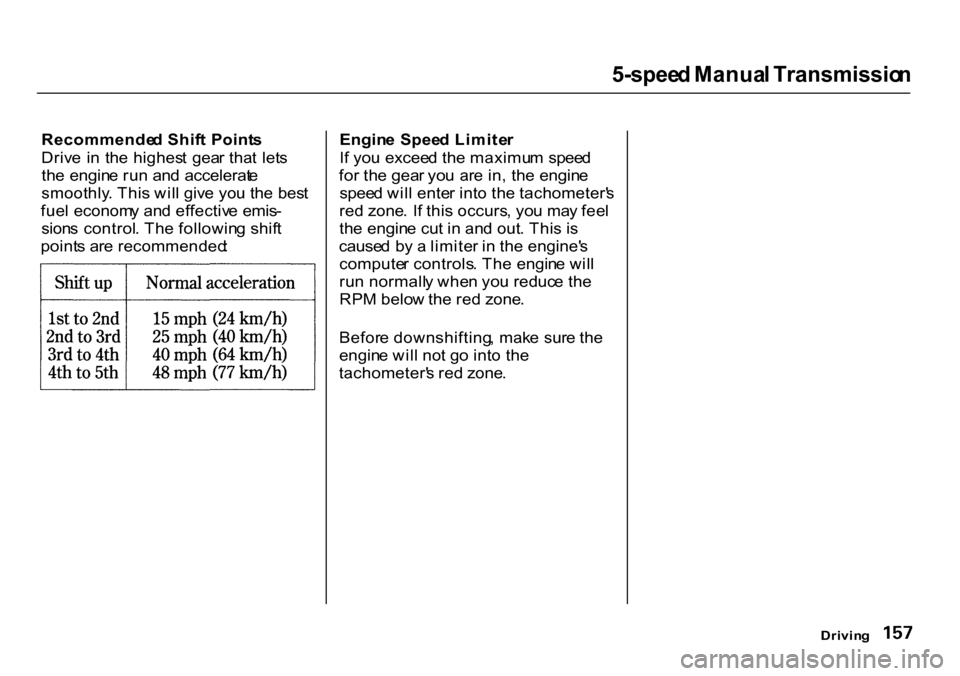
5-spee
d Manua l Transmissio n
Recommende d Shif t Point s
Driv e i n th e highes t gea r tha t let s
th e engin e ru n an d accelerat e
smoothly . Thi s wil l giv e yo u th e bes t
fue l econom y an d effectiv e emis -
sion s control . Th e followin g shif t
point s ar e recommended : Engin
e Spee d Limite r
I f yo u excee d th e maximu m spee d
fo r th e gea r yo u ar e in , th e engin e
spee d wil l ente r int o th e tachometer' s
re d zone . I f thi s occurs , yo u ma y fee l
th e engin e cu t i n an d out . Thi s i s
cause d b y a limite r i n th e engine' s
compute r controls . Th e engin e wil l
ru n normall y whe n yo u reduc e th e
RP M belo w th e re d zone .
Befor e downshifting , mak e sur e th e
engin e wil l no t g o int o th e
tachometer' s re d zone .
Driving
Page 162 of 322
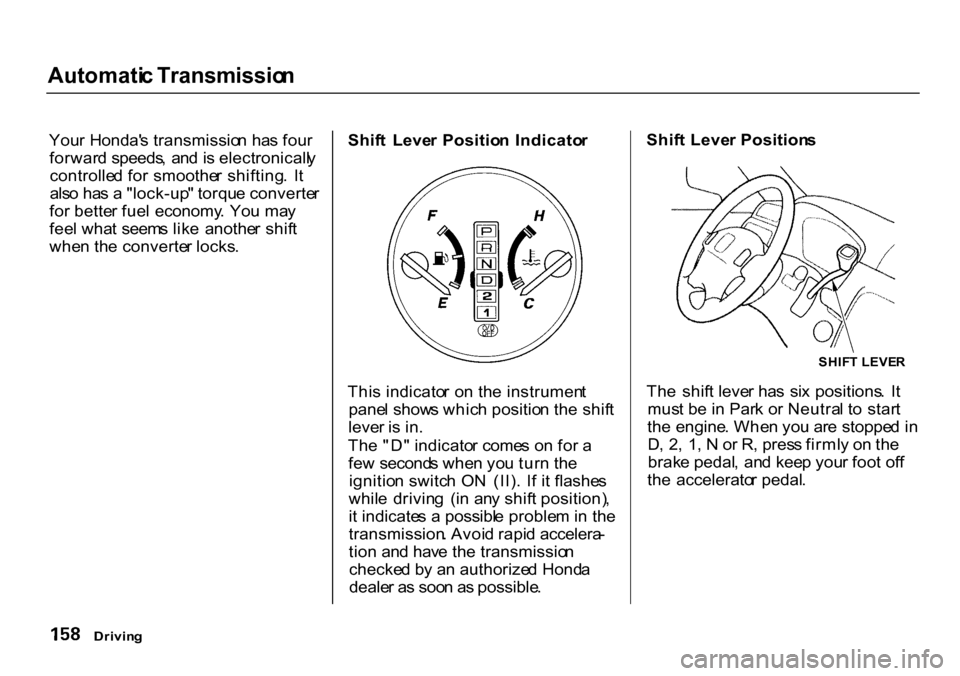
Automati
c Transmissio n
You r Honda' s transmissio n ha s fou r
forwar d speeds , an d is electronicall y
controlle d fo r smoothe r shifting . I t
als o ha s a "lock-up " torqu e converte r
fo r bette r fue l economy . Yo u ma y
fee l wha t seem s lik e anothe r shif t
whe n th e converte r locks . Shif
t Leve r Positio n Indicato r
Thi s indicato r o n th e instrumen t
pane l show s whic h positio n th e shif t
leve r i s in .
Th e "D " indicato r come s o n fo r a
fe w second s whe n yo u tur n th e
ignitio n switc h O N (II) . I f i t flashe s
whil e drivin g (i n an y shif t position) ,
i t indicate s a possibl e proble m in th e
transmission . Avoi d rapi d accelera -
tio n an d hav e th e transmissio n
checke d b y a n authorize d Hond a
deale r a s soo n a s possible . Shif
t Leve r Position s
Th e shif t leve r ha s si x positions . I t
mus t b e in Par k o r Neutra l t o star t
th e engine . Whe n yo u ar e stoppe d i n
D , 2 , 1 , N or R , pres s firml y o n th e
brak e pedal , an d kee p you r foo t of f
th e accelerato r pedal .
Drivin g
SHIF
T LEVE R
Page 163 of 322
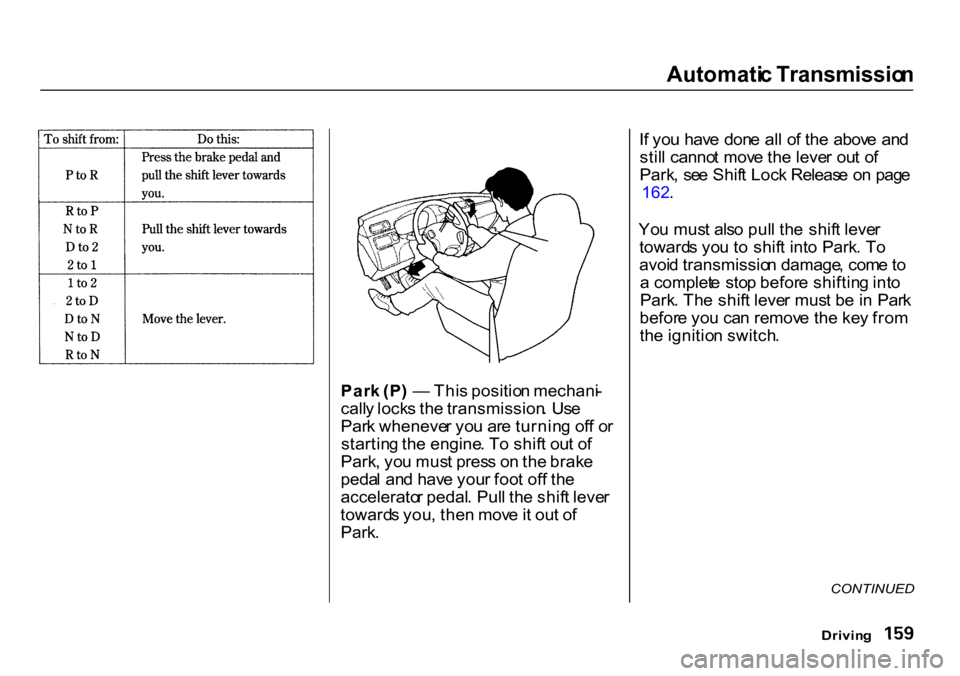
Automati
c Transmissio n
Par k (P ) — Thi s positio n mechani -
call y lock s th e transmission . Us e
Par k wheneve r yo u ar e turnin g of f o r
startin g th e engine . T o shif t ou t o f
Park , yo u mus t pres s o n th e brak e
peda l an d hav e you r foo t of f th e
accelerato r pedal . Pul l th e shif t leve r
toward s you , the n mov e it ou t o f
Park .
I
f yo u hav e don e al l o f th e abov e an d
stil l canno t mov e th e leve r ou t o f
Park , se e Shif t Loc k Releas e o n pag e
162 .
Yo u mus t als o pul l th e shif t leve r
toward s yo u t o shif t int o Park . T o
avoi d transmissio n damage , com e to
a complet e sto p befor e shiftin g int o
Park . Th e shif t leve r mus t b e in Par k
befor e yo u ca n remov e th e ke y fro m
th e ignitio n switch .
CONTINUED
Drivin g
Page 164 of 322
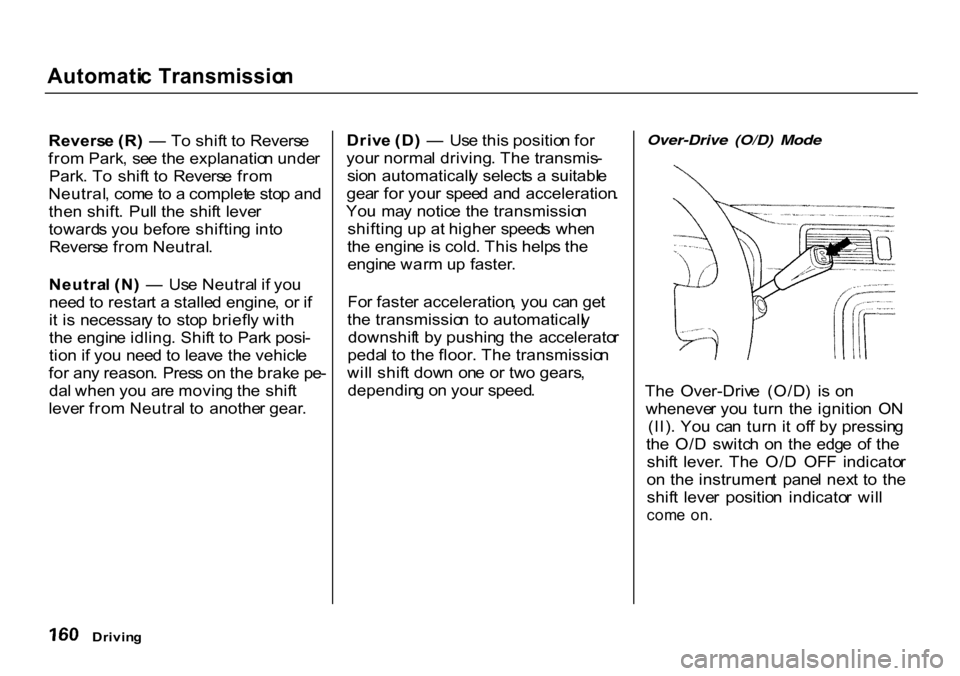
Automati
c Transmissio n
Revers e (R ) — To shif t t o Revers e
fro m Park , se e th e explanatio n unde r
Park . T o shif t t o Revers e fro m
Neutral , com e t o a complet e sto p an d
the n shift . Pul l th e shif t leve r
toward s yo u befor e shiftin g int o
Revers e fro m Neutral .
Neutra l (N ) — Us e Neutra l i f yo u
nee d t o restar t a stalle d engine , o r i f
i t i s necessar y t o sto p briefl y wit h
th e engin e idling . Shif t t o Par k posi -
tio n if yo u nee d t o leav e th e vehicl e
fo r an y reason . Pres s o n th e brak e pe -
da l whe n yo u ar e movin g th e shif t
leve r fro m Neutra l t o anothe r gear . Driv
e (D ) — Us e thi s positio n fo r
you r norma l driving . Th e transmis -
sio n automaticall y select s a suitabl e
gea r fo r you r spee d an d acceleration .
Yo u ma y notic e th e transmissio n
shiftin g up at highe r speed s whe n
th e engin e is cold . Thi s help s th e
engin e war m u p faster .
Fo r faste r acceleration , yo u ca n ge t
th e transmissio n t o automaticall y
downshif t b y pushin g th e accelerato r
peda l t o th e floor . Th e transmissio n
wil l shif t dow n on e o r tw o gears ,
dependin g o n you r speed .
Over-Drive (O/D) Mode
Th e Over-Driv e (O/D ) i s o n
wheneve r yo u tur n the ignitio n O N
(II) . Yo u ca n tur n i t of f b y pressin g
th e O/ D switc h o n the edg e o f th e
shif t lever . Th e O/ D OF F indicato r
o n the instrumen t pane l nex t t o th e
shif t leve r positio n indicato r wil l
com e on .
Drivin g
Page 165 of 322
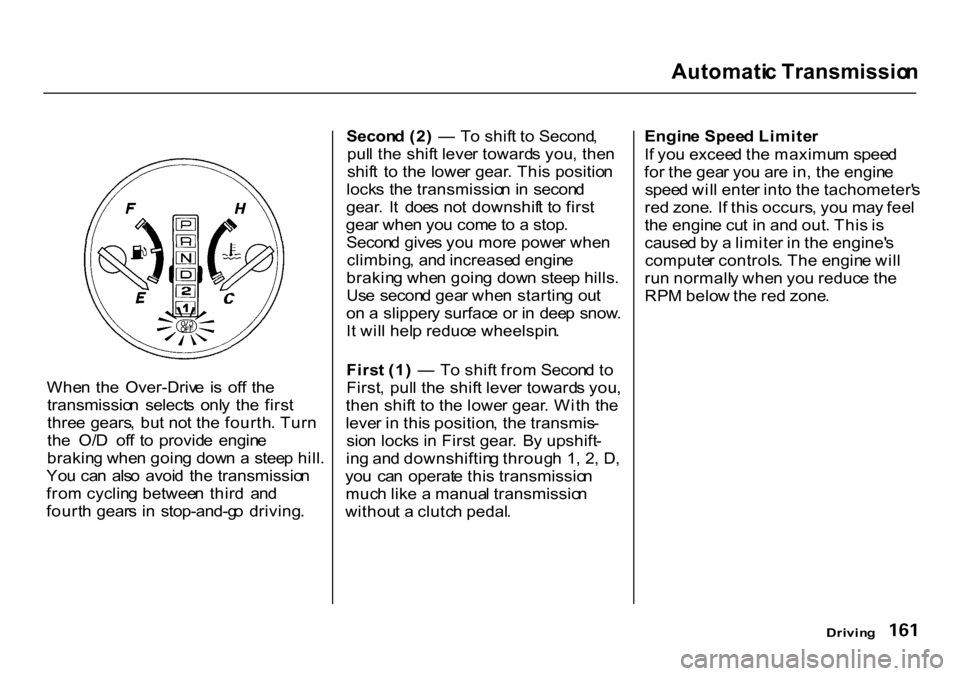
Automati
c Transmissio n
Whe n th e Over-Driv e i s of f th e
transmissio n select s onl y th e firs t
thre e gears , bu t no t th e fourth . Tur n
th e O/ D of f t o provid e engin e
brakin g whe n goin g dow n a stee p hill .
Yo u ca n als o avoi d the transmissio n
fro m cyclin g betwee n thir d an d
fourt h gear s i n stop-and-g o driving .Secon
d (2 ) — To shif t t o Second ,
pul l th e shif t leve r toward s you , the n
shif t t o th e lowe r gear . Thi s positio n
lock s th e transmissio n in secon d
gear . I t doe s no t downshif t t o firs t
gea r whe n yo u com e t o a stop .
Secon d give s yo u mor e powe r whe n
climbing , an d increase d engin e
brakin g whe n goin g dow n stee p hills .
Us e secon d gea r whe n startin g ou t
o n a slipper y surfac e o r i n dee p snow .
I t wil l hel p reduc e wheelspin .
Firs t (1 ) — To shif t fro m Secon d t o
First , pul l th e shif t leve r toward s you ,
the n shif t t o th e lowe r gear . Wit h th e
leve r i n thi s position , th e transmis -
sio n lock s i n Firs t gear . B y upshift -
in g an d downshiftin g throug h 1 , 2 , D ,
yo u ca n operat e thi s transmissio n
muc h lik e a manua l transmissio n
withou t a clutc h pedal . Engin
e Spee d Limite r
I f yo u excee d th e maximu m spee d
fo r th e gea r yo u ar e in , th e engin e
spee d wil l ente r int o th e tachometer' s
re d zone . I f thi s occurs , yo u ma y fee l
th e engin e cu t i n an d out . Thi s is
cause d b y a limite r i n th e engine' s
compute r controls . Th e engin e wil l
ru n normall y whe n yo u reduc e th e
RP M belo w th e re d zone .
Drivin g
Page 166 of 322
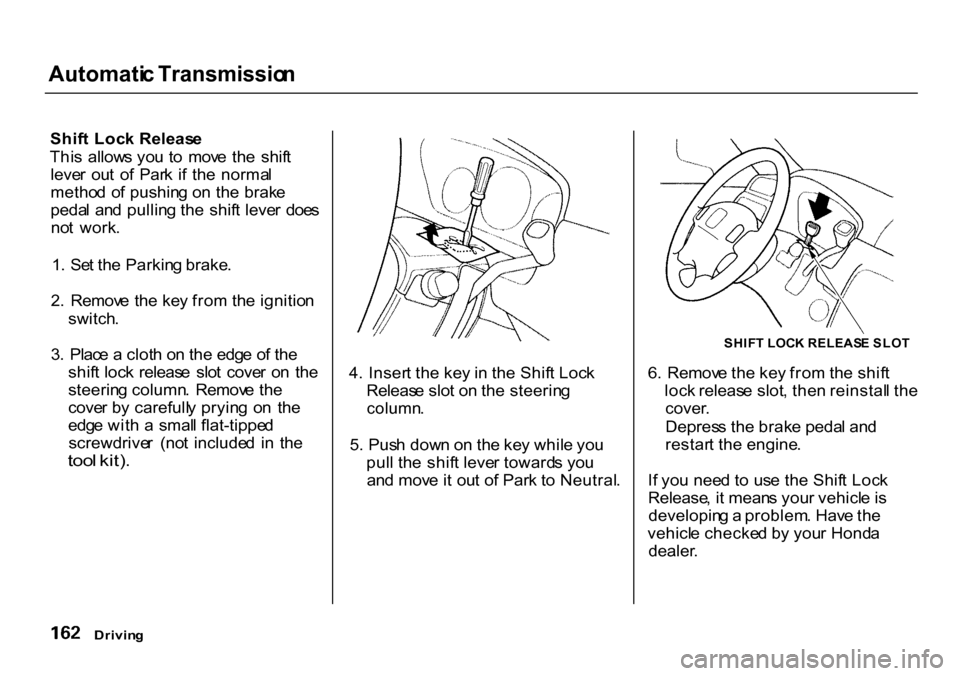
Automati
c Transmissio n
Shif t Loc k Releas e
Thi s allow s yo u t o mov e th e shif t
leve r ou t o f Par k i f the norma l
metho d o f pushin g o n th e brak e
peda l an d pullin g the shif t leve r doe s
no t work .
1 . Se t th e Parkin g brake .
2 . Remov e th e ke y fro m th e ignitio n
switch .
3 . Plac e a clot h o n the edg e o f th e
shif t loc k releas e slo t cove r o n th e
steerin g column . Remov e th e
cove r b y carefull y pryin g o n th e
edg e wit h a smal l flat-tippe d
screwdrive r (no t include d i n th e
too l kit) .
4
. Inser t th e ke y i n th e Shif t Loc k
Releas e slo t o n th e steerin g
column .
5 . Pus h dow n o n th e ke y whil e yo u
pul l th e shif t leve r toward s yo u
an d mov e it ou t o f Par k t o Neutral . SHIF
T LOC K RELEAS E SLO T
6 . Remov e th e ke y fro m th e shif t
loc k releas e slot , the n reinstal l th e
cover .
Depres s th e brak e peda l an d
restar t th e engine .
I f yo u nee d t o us e th e Shif t Loc k
Release , i t mean s you r vehicl e is
developin g a problem . Hav e th e
vehicl e checke d b y you r Hond a
dealer .
Drivin g
Page 167 of 322
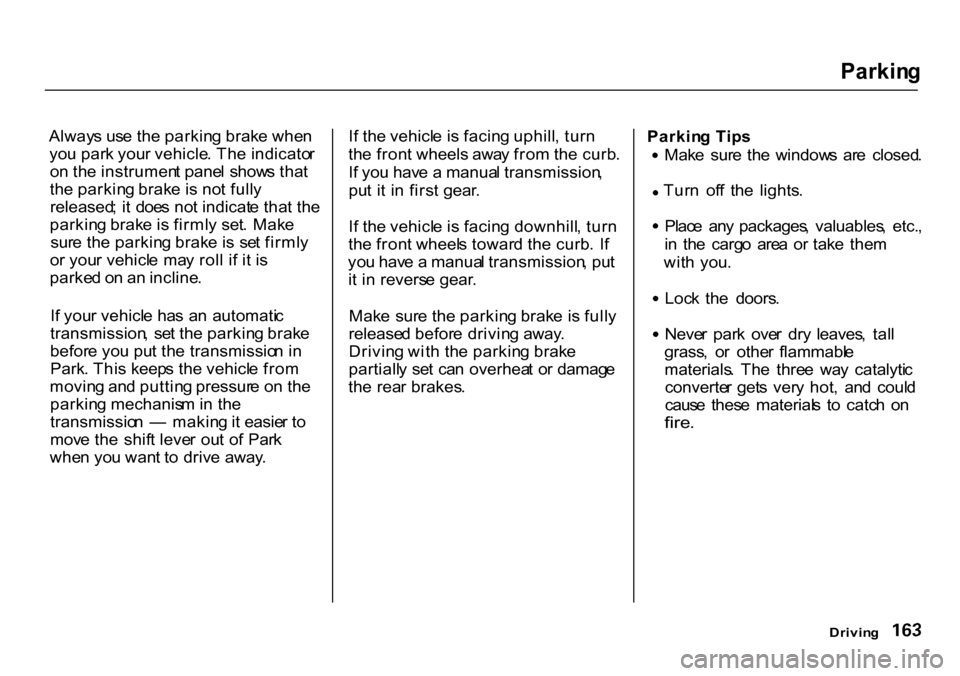
Parkin
g
Alway s us e th e parkin g brak e whe n
yo u par k you r vehicle . Th e indicato r
o n th e instrumen t pane l show s tha t
th e parkin g brak e is no t full y
released ; i t doe s no t indicat e tha t th e
parkin g brak e is firml y set . Mak e
sur e th e parkin g brak e is se t firml y
o r you r vehicl e ma y rol l i f i t i s
parke d o n a n incline .
I f you r vehicl e ha s a n automati c
transmission , se t th e parkin g brak e
befor e yo u pu t th e transmissio n i n
Park . Thi s keep s th e vehicl e fro m
movin g an d puttin g pressur e o n th e
parkin g mechanis m in th e
transmissio n — makin g it easie r t o
mov e th e shif t leve r ou t o f Par k
whe n yo u wan t t o driv e away . I
f th e vehicl e i s facin g uphill , tur n
th e fron t wheels away fro m th e curb .
I f yo u hav e a manua l transmission ,
pu t i t i n firs t gear .
I f th e vehicl e i s facin g downhill , tur n
th e fron t wheel s towar d th e curb . I f
yo u hav e a manua l transmission , pu t
i t i n revers e gear .
Mak e sur e th e parkin g brak e i s full y
release d befor e drivin g away .
Drivin g wit h th e parkin g brak e
partiall y se t ca n overhea t o r damag e
th e rea r brakes . Parkin
g Tip s Mak
e sur e th e window s ar e closed . Tur
n of f th e lights . Plac
e an y packages , valuables , etc. ,
i n th e carg o are a o r tak e the m
wit h you . Loc
k th e doors . Neve
r par k ove r dr y leaves , tal l
grass , o r othe r flammabl e
materials . Th e thre e wa y catalyti c
converte r get s ver y hot , an d coul d
caus e thes e material s t o catc h o n
fire .
Driving
Page 168 of 322
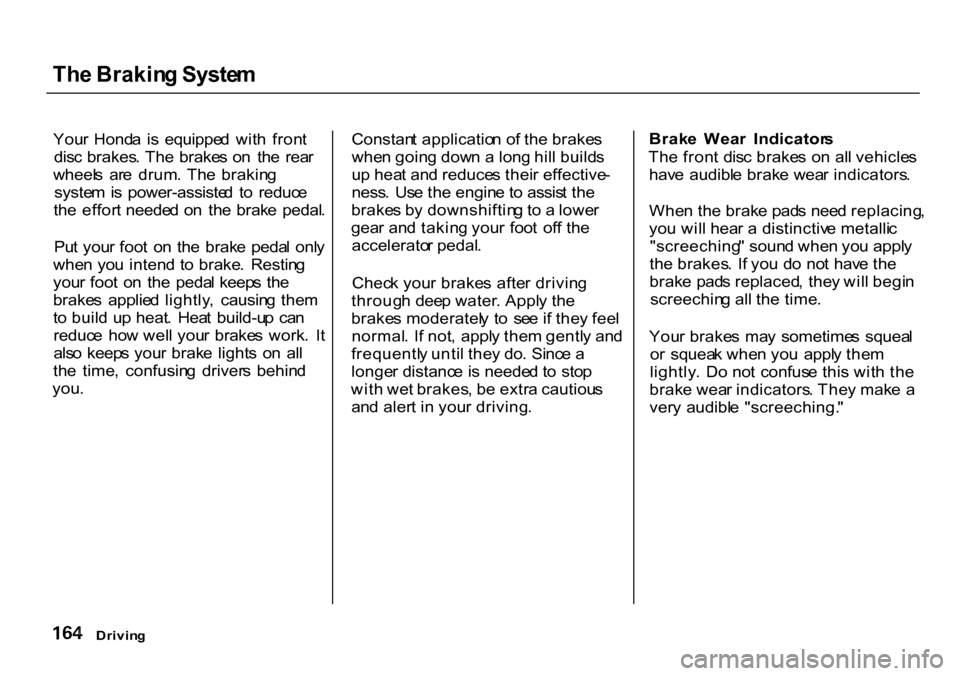
Th
e Brakin g Syste m
You r Hond a i s equippe d wit h fron t
dis c brakes . Th e brake s o n th e rea r
wheel s ar e drum . Th e brakin g
syste m is power-assiste d t o reduc e
th e effor t neede d o n th e brak e pedal .
Pu t you r foo t o n th e brak e peda l onl y
whe n yo u inten d t o brake . Restin g
you r foo t o n th e peda l keep s th e
brake s applie d lightly , causin g the m
t o buil d u p heat . Hea t build-u p ca n
reduc e ho w wel l you r brake s work . I t
als o keep s you r brak e light s o n al l
th e time , confusin g driver s behin d
you .
Constan
t applicatio n o f th e brake s
whe n goin g dow n a lon g hil l build s
u p hea t an d reduce s thei r effective -
ness . Us e th e engin e to assis t th e
brake s b y downshiftin g to a lowe r
gea r an d takin g you r foo t of f th e
accelerato r pedal .
Chec k you r brake s afte r drivin g
throug h dee p water . Appl y th e
brake s moderatel y t o se e if the y fee l
normal . I f not , appl y the m gentl y an d
frequentl y unti l the y do . Sinc e a
longe r distanc e is neede d t o sto p
wit h we t brakes , b e extr a cautiou s
an d aler t i n you r driving . Brak
e Wea r Indicator s
Th e fron t dis c brake s o n al l vehicle s
hav e audibl e brak e wea r indicators .
Whe n th e brak e pad s nee d replacing ,
yo u wil l hea r a distinctiv e metalli c
"screeching " soun d whe n yo u appl y
th e brakes . I f yo u d o no t hav e th e
brak e pad s replaced , the y wil l begi n
screechin g al l th e time .
You r brake s ma y sometime s squea l
o r squea k whe n yo u appl y the m
lightly . D o no t confus e thi s wit h th e
brak e wea r indicators . The y mak e a
ver y audibl e "screeching. "
Drivin g
Page 169 of 322
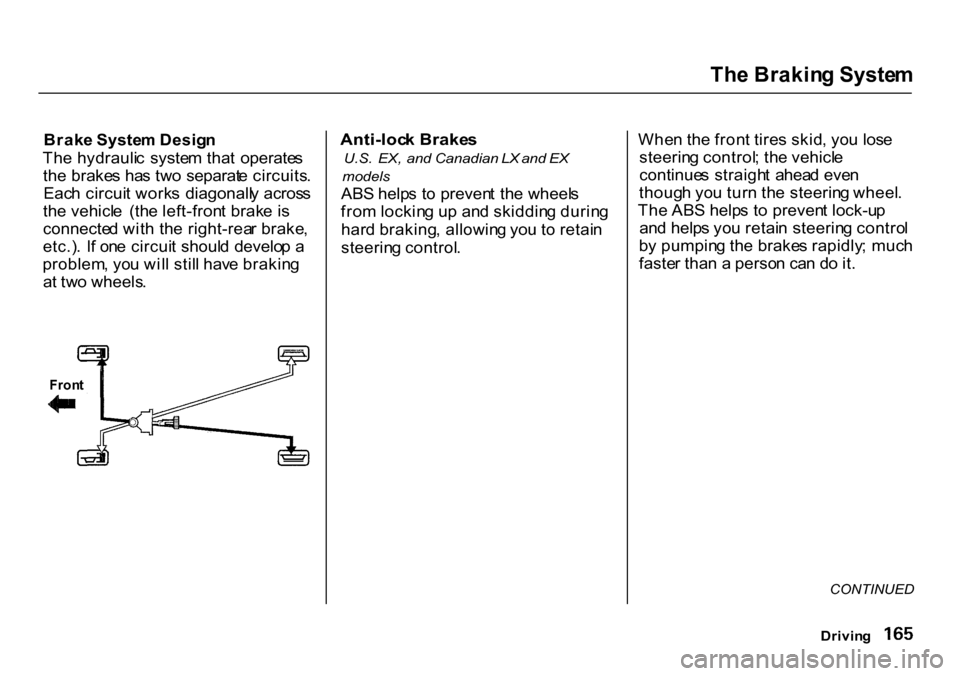
Th
e Brakin g Syste m
Brak e Syste m Desig n
Th e hydrauli c syste m tha t operate s
th e brake s ha s tw o separat e circuits .
Eac h circui t work s diagonall y acros s
th e vehicl e (th e left-fron t brak e i s
connecte d wit h th e right-rea r brake ,
etc.) . I f on e circui t shoul d develo p a
problem , yo u wil l stil l hav e brakin g
a t tw o wheels .
Anti-loc
k Brake s
U.S. EX, and Canadian LX and EX
models
AB S help s t o preven t th e wheel s
fro m lockin g u p an d skiddin g durin g
har d braking , allowin g yo u t o retai n
steerin g control . Whe
n th e fron t tire s skid , yo u los e
steerin g control ; th e vehicl e
continue s straigh t ahea d eve n
thoug h yo u tur n th e steerin g wheel .
Th e AB S help s t o preven t lock-u p
an d help s yo u retai n steerin g contro l
b y pumpin g th e brake s rapidly ; muc h
faste r tha n a perso n ca n d o it .
CONTINUED
Fron
t
Driving
Page 170 of 322
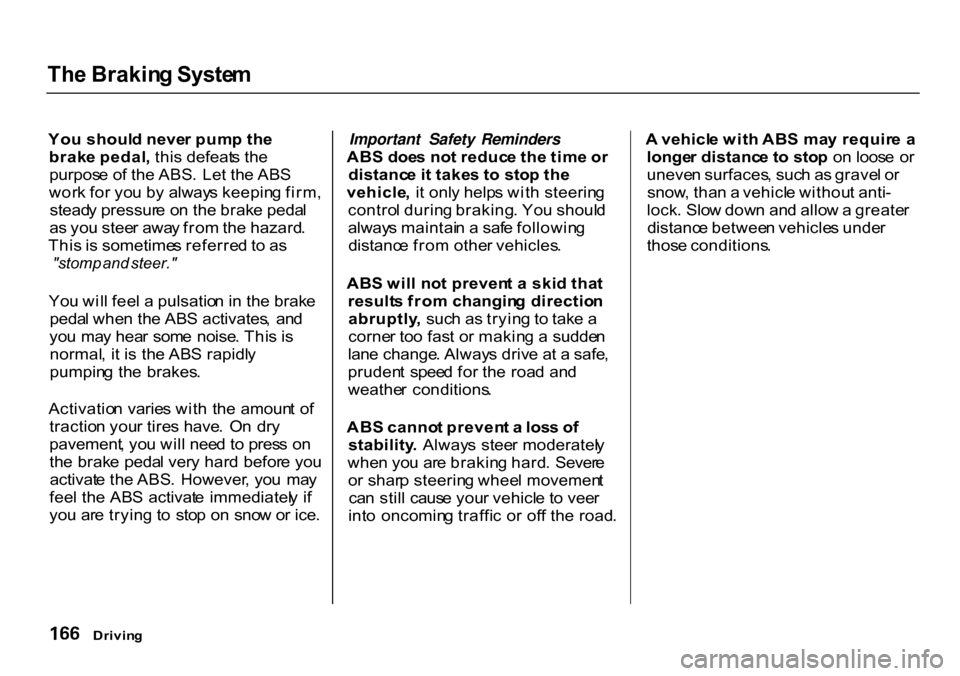
Th
e Brakin g Syste m
Yo u shoul d neve r pum p th e
brak e pedal , thi s defeat s th e
purpos e o f th e ABS . Le t th e AB S
wor k fo r yo u b y alway s keepin g firm ,
stead y pressur e o n th e brak e peda l
a s yo u stee r awa y fro m th e hazard .
Thi s is sometime s referre d to a s
"stomp and steer."
Yo u wil l fee l a pulsatio n in th e brak e
peda l whe n th e AB S activates , an d
yo u ma y hea r som e noise . Thi s i s
normal , i t i s th e AB S rapidl y
pumpin g th e brakes .
Activatio n varie s wit h th e amoun t o f
tractio n you r tire s have . O n dr y
pavement , yo u wil l nee d t o pres s o n
th e brak e peda l ver y har d befor e yo u
activat e th e ABS . However , yo u ma y
fee l th e AB S activat e immediatel y i f
yo u ar e tryin g t o sto p o n sno w o r ice .
Important Safety Reminders
AB S doe s no t reduc e th e tim e o r
distanc e i t take s t o sto p th e
vehicle , i t onl y help s wit h steerin g
contro l durin g braking . Yo u shoul d
alway s maintai n a saf e followin g
distanc e fro m othe r vehicles .
AB S wil l no t preven t a ski d tha t
result s fro m changin g directio n
abruptly , suc h a s tryin g to tak e a
corne r to o fas t o r makin g a sudde n
lan e change . Alway s driv e a t a safe ,
pruden t spee d fo r th e roa d an d
weathe r conditions .
AB S canno t preven t a los s o f
stability . Alway s stee r moderatel y
whe n yo u ar e brakin g hard . Sever e
o r shar p steerin g whee l movemen t
ca n stil l caus e you r vehicl e t o vee r
int o oncomin g traffi c o r of f th e road .A
vehicl e wit h AB S ma y requir e a
longe r distanc e t o sto p o n loos e o r
uneve n surfaces , suc h a s grave l o r
snow , tha n a vehicl e withou t anti -
lock . Slo w dow n an d allo w a greate r
distanc e betwee n vehicle s unde r
thos e conditions .
Drivin g